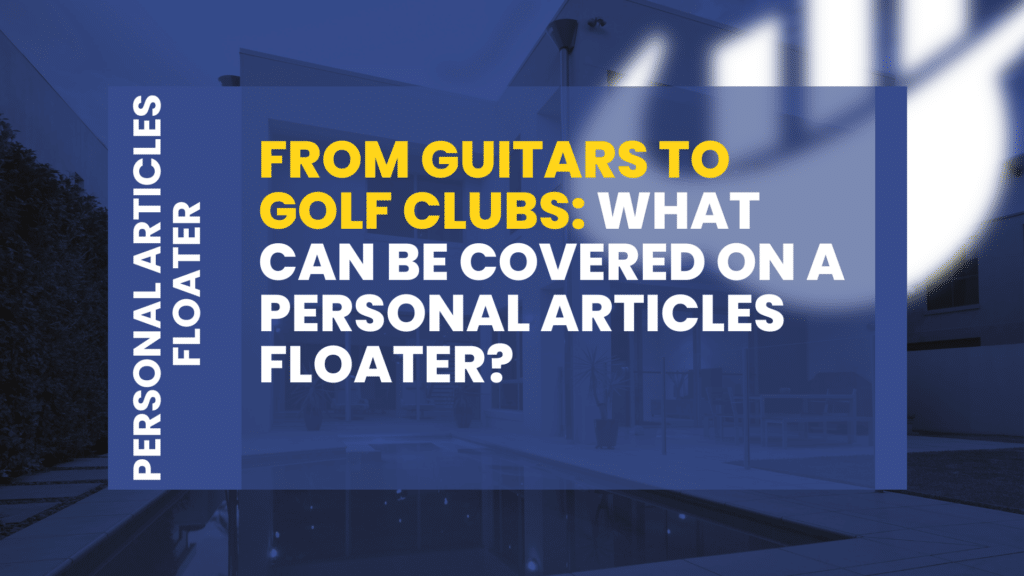-
Main Office: 1434 E. Bloomingdale Ave Valrico, FL 33596-6110
-
Phone: (888) 601-6660
-
Email: info@floridariskpartners.com

When most people think of a Personal Articles Floater (PAF), they assume it’s for jewelry or fine art. While those are common uses, a PAF can insure a wide variety of valuable property. It offers customization and protection far beyond a standard homeowners policy.
As we covered in the first two posts of this 12-week series, homeowners insurance policies come with strict limitations when it comes to high-value or unique items. They may be subject to sublimits, exclusions, or depreciation that severely reduce the payout in the event of a claim—or deny it altogether. That’s why understanding what can be covered on a PAF is so important.
This week, we’ll explore the types of items eligible for personal articles coverage. We’ll explain why each category is vulnerable to underinsurance. We’ll also provide a roadmap for identifying what in your household may need to be scheduled on a floater. Spoiler alert: it’s not just rings and paintings.
Understanding the Flexibility of Personal Articles Coverage
One of the biggest advantages of a Personal Articles Floater is insuring items individually or as a class. You can insure them at a declared or appraised value, often with no deductible. You don’t need to insure everything—just items with significant financial or sentimental value or those difficult to replace with standard homeowners coverage.
Unlike general personal property coverage, often subject to per-category sublimits, a floater bypasses those restrictions. You can insure a $10,000 engagement ring, a $7,000 cello, or a $15,000 camera kit for their full value. This ensures they’re protected worldwide, giving you peace of mind.
Let’s explore the broad list of items that can be insured with a personal articles floater.
Jewelry and Watches
Let’s start with the most well-known category. Jewelry is by far the most commonly floated personal property, and for good reason. Standard homeowners policies generally limit theft coverage for jewelry to $1,500 to $2,500 total, regardless of how many pieces you own.
If you have a wedding ring, diamond studs, luxury watch, or inherited heirloom jewelry, the value of those pieces can quickly exceed what your policy covers. A floater allows you to insure each piece for its appraised value and provides protection for loss, theft, mysterious disappearance, and damage, often with no deductible.
Even if your jewelry doesn’t feel particularly valuable to someone else, if it would be painful or expensive for you to replace, it likely deserves a spot on your floater.
Cameras and Photography Equipment
Photography equipment is another high-risk category, especially if used professionally or during travel. DSLR bodies, lenses, lighting equipment, tripods, drones, and editing accessories can quickly add up to thousands of dollars. A homeowners policy may not cover gear that’s used even occasionally for business purposes and often has depreciation built in.

By scheduling your camera equipment on a PAF, you can protect it from theft, accidental damage, and loss whether you’re shooting a wedding across town or hiking with your gear in another country.
Musical Instruments
Whether you’re a musician, student, or hobbyist, instruments are expensive and uniquely valuable. Guitars, violins, pianos, brass, woodwind instruments, and recording equipment range in price from hundreds to tens of thousands of dollars.
Instruments are vulnerable to damage and travel loss. Many homeowners policies don’t cover them if used for paid performances. Scheduling them on a floater ensures full coverage wherever they go.
Fine Art, Antiques, and Sculptures
Fine art and antiques are difficult to appraise after a loss and may lack adequate coverage. They require a professional appraisal at scheduling and benefit from agreed value coverage.
Whether you own paintings, rare sculptures, antique furniture, or decorative art objects, a floater insures them at their documented value. It protects against risks like fire, theft, and accidental damage.
It’s important to note that art values can appreciate over time, so it’s wise to have your collection appraised periodically and update your coverage accordingly.
Collectibles
Collecting is a passion for many, but homeowners insurance often fails to cover it. Coins, stamps, baseball cards, rare books, comic books, sports memorabilia, and vintage toys are frequently excluded or limited under standard policies.
A personal articles floater offers the ability to insure collectibles based on market value and provides more comprehensive protection, especially against theft or damage during transport or display.
Firearms
Gun ownership carries responsibility and risk. Homeowners insurance may provide small coverage for firearms, typically up to $2,500 for theft. This is often not enough to cover one or two quality firearms, let alone a full collection.
A floater allows individual scheduling of each firearm, including accessories like scopes, safes, or holsters. It offers broader protection than a standard policy and is a vital part of a responsible firearm owner’s risk management strategy.
Sports Equipment
Today’s sports and fitness gear isn’t cheap. Golf clubs, bicycles, fishing gear, skis, snowboards, and training equipment can all be floated. A custom set of golf clubs may cost over $3,000, and a competitive bicycle can exceed $10,000.
This gear is often used away from home, prone to theft or damage, and rarely fully covered under homeowners insurance. A floater allows you to schedule this equipment for its true value, making it a smart move for athletes and hobbyists alike.
Designer Handbags and Fashion Accessories
Luxury handbags, shoes, and accessories are high-theft items, and their value adds up quickly. Brands like Louis Vuitton, Chanel, and Gucci command high resale prices, making them attractive to thieves and hard to replace without proper coverage.
These items are grouped under personal property but receive little to no specific coverage under homeowners insurance. A floater lists, values, and covers each item individually, making it easier to get reimbursed after a loss.
Electronics and Smart Devices

Some electronics are covered under a standard homeowners policy but face depreciation and exclusions. Business-use exclusions and limited theft coverage also apply. If you own high-end laptops, tablets, smartwatches, drones, or gaming systems, consider floating them for better protection.
A floater provides broader and more consistent protection, especially for those who travel frequently or use their devices in non-traditional settings like gigs, content creation, or side hustles.
Wine Collections and Rare Spirits
Yes, even your wine cellar can be insured. Rare and collectible wine, champagne, or spirits collections are not typically covered under standard homeowners insurance unless specifically endorsed.
A floater offers protection against risks like breakage, temperature control failure, theft, and fire, making it an essential tool for oenophiles and collectors alike.
Specialty Tools and Equipment
If you have a garage or workshop filled with specialty tools, their value can quickly reach thousands. Homeowners policies often exclude or limit coverage for tools used for business, even part-time.
Floating your tools allows you to insure them for their true replacement cost and ensures they’re protected even when taken off-premises or used during paid work.
What Can’t Be Floated?
While the list of eligible items is long, there are a few categories that typically can’t be insured via a personal articles floater:
- Vehicles, motorcycles, or ATVs (covered under auto insurance)
- Pets and animals
- Business inventory or large commercial equipment
- Certain types of data or software
It’s always best to check with your insurance advisor to confirm whether an item qualifies and what documentation may be needed.
How to Get Started
If you’re wondering whether your belongings qualify for a floater, the best place to start is by doing a personal inventory. Walk through your home and make a list of:
- Any single item worth over $1,000
- Items that would be emotionally difficult or financially costly to replace
- Items that travel with you frequently or are used outside the home
- Anything that falls into one of the categories we’ve covered
Once your list is complete, reach out to your insurance agent for a coverage review. They’ll help determine what should be scheduled, whether appraisals are needed, and what options make the most sense for your lifestyle and risk profile.
Final Thoughts
From guitars to golf clubs, handbags to hard drives, our possessions are often more valuable than we think. Unfortunately, standard homeowners insurance doesn’t keep up with how we live, work, and travel. You must ensure the right items are properly protected.
A Personal Articles Floater gives you that protection. It’s customizable, portable, and comprehensive—and it ensures that the belongings you love don’t leave you financially exposed.
Join us next week as we explore the emotional side of insurance and why protecting items with sentimental value is just as important as covering their monetary worth.
And as always, if you’d like to schedule a personal insurance review or need help identifying which items in your home may need to be floated, our team is here to help.
Call Us Or
Schedule an Appointment
Select an agent below to view our online calendars and select a day and time that works best for you or call us directly at 888-601-6660. When you use our online calendars, you will receive an email with more information.



